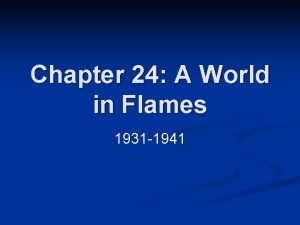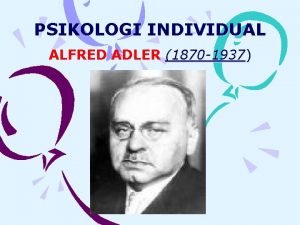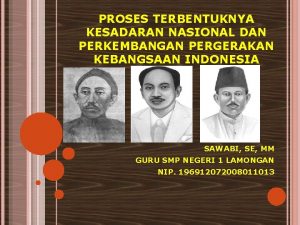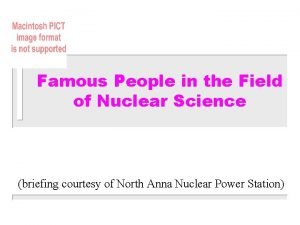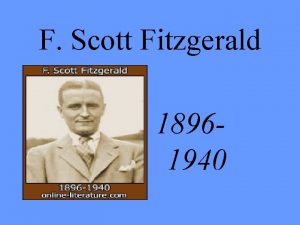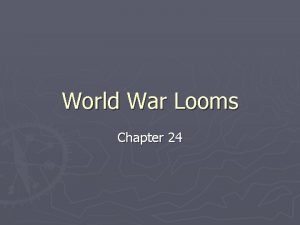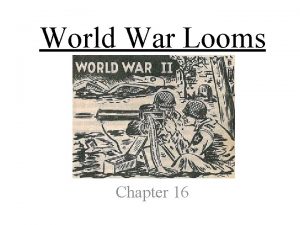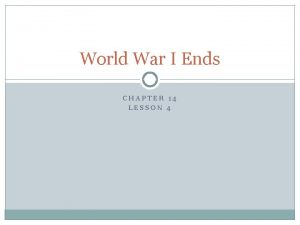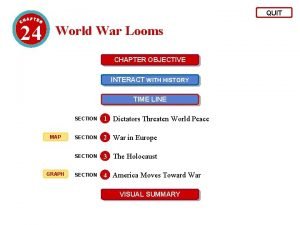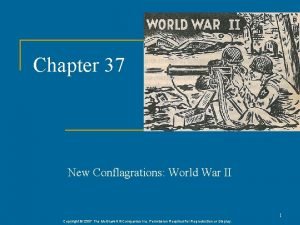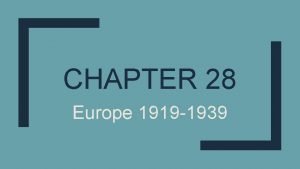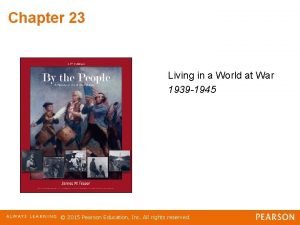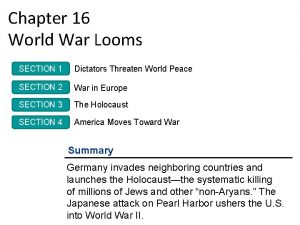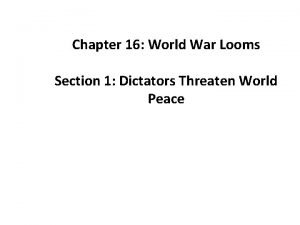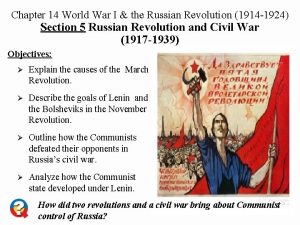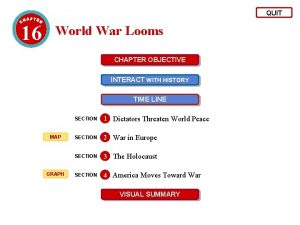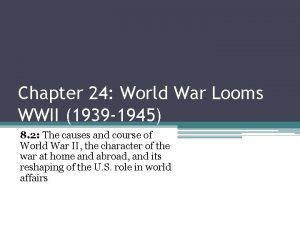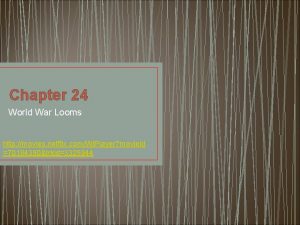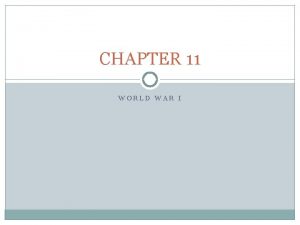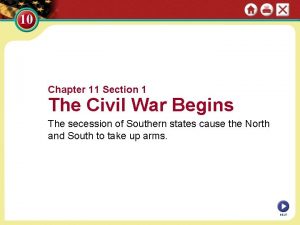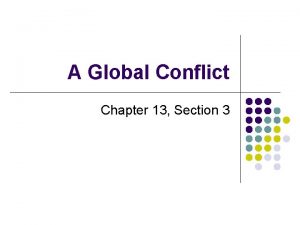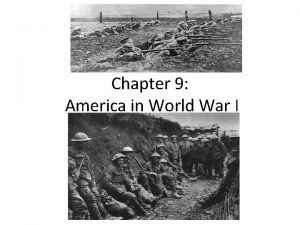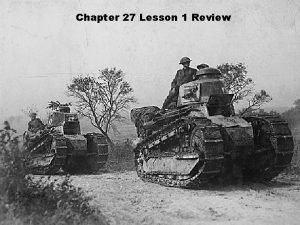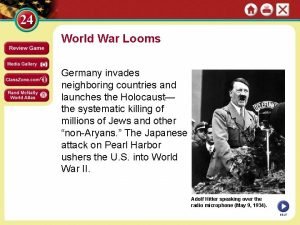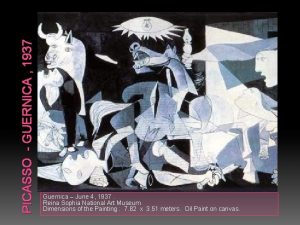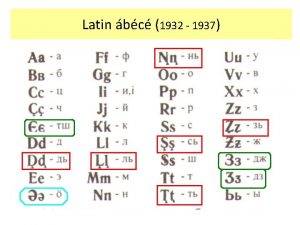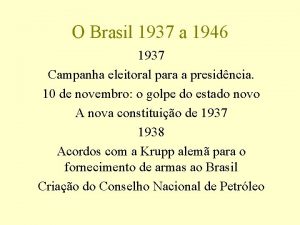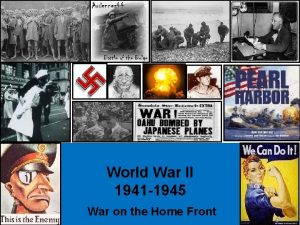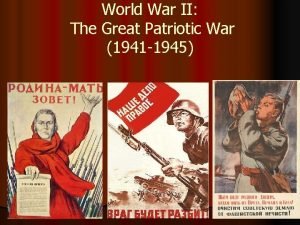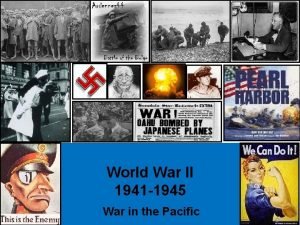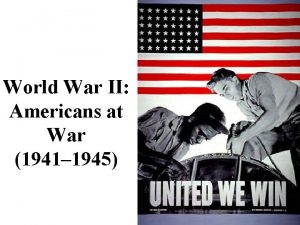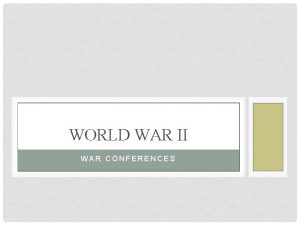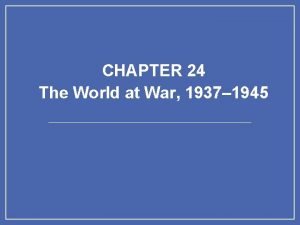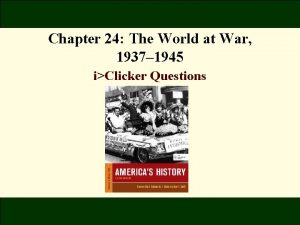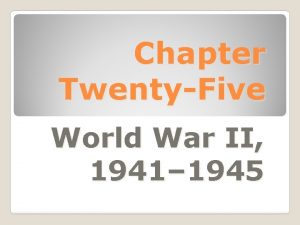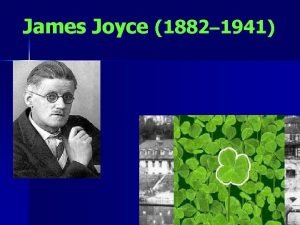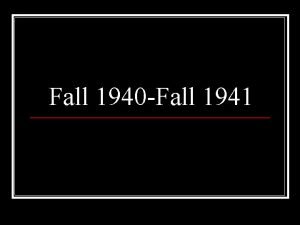Chapter 9 WORLD WAR II 1937 1940 1941







































- Slides: 39

Chapter 9 WORLD WAR II (1937 -1940) (1941 -1945)

BACKGROUND The US was still facing the ravages of the Great Depression Worldwide economic collapse caused financial disaster in Europe Germany defaulted on WWI reparations Most European nations could not repay their debt to the US Instability led to the rise of dictatorships in Italy and Germany Japan was invading other Pacific nations to obtain raw materials the island nation lacked Most importantly, the US had been solely focused on domestic affairs and had paid little attention to foreign issues, with the exception of Latin America

The Road to War Adolf Hitler � Born in Austria 1889 � Becomes the Chancellor of Germany two months before Roosevelt’s inauguration � Served in the German Army during WWI � Like most Germans, he was angered by the harsh terms in the Treaty of Versailles � Blamed Germany’s defeat on the Jews and Communists � Suspended the constitution of Germany and named himself the Fueher and dictator, and then set out to conquer Europe � In 1934, he announced � German rearmament (violation of the Treaty)

The Road to War Benito Mussolini Born 1883 � Was an Italian politician, journalist, and leader of the National Fascist Party � Became youngest Italian Prime Minister in 1922 � He ruled constitutionally until 1925, when he dropped all pretense of democracy and set up a legal dictatorship � Known as Il Duce (“the leader”) � Mussolini was one of the key figures in the creation of Fascism � In 1912, he was the leading member of the National Directorate of the Italian Socialist Party (PSI) � In 1934, he threatened to invade Ethiopia � This frightened the US as they were at the time reexamining the history of Americas entry into WWI and vowing it would never happen again

The Road to War Evaluating America � Senator Gerald P. Nye (North Dakota) launched an investigation into the connection between corporate profits and American participation in WWI. His committee’s public hearings revealed that American businessmen had close relations with the War Department. Although no conspiracy was proved, it was easy to conclude that the US had been tricked into going to war by the people who profited heavily from it. � Students across the nation, at many universities, demonstrated against the war They were determined to never support a foreign war again

The Beginning In May 1935, Italy invaded Ethiopia � Rejected League of Nations offer to mediate disputes between both nations In response, a frightened US passed the Neutrality Act As the League of Nations condemned Italy as the aggressor, Roosevelt used the authority of the Neutrality Act to impose an arms embargo Authorized the president to prohibit all arms shipments to nations at war and to advise all US citizens not to travel on belligerents’ ships except at their own risk. Congress was determined to prevent America from entering another world war But in the midst of the depression, he was not willing to stop oil shipments to Italy or join the fight That decision had disastrous effects on the poor African nation Mussolini defeated Ethiopia rather quickly, and then made an alliance with Germany, creating the Rome-Berlin Axis, in 1936

The Beginning General Francisco Franco revolted against the republican government of Spain Supported by the Catholic Church, large landowners, and reactionary politicians � Germany and Italy supported Franco with planes and other weapons � The Soviet Union supplied the Spanish republican loyalists � The war in Spain polarized the US � Most Catholics and many anti-Communists supported Franco American liberals and radicals supported the republican cause The US remained adamant about neutrality, signing another Neutrality Act in 1936 � 3, 000 Americans joined the Abraham Lincoln Brigade, and hundreds would die fighting Fascism Extended the provisions of the first and included a ban on loans to belligerents Roosevelt asked Congress to extend the arms embargo to Spain Franco wins the Civil War in Spain and forms his dictatorship The assistance of Germany and Italy made the victory possible In 1937, the US passed another Neutrality Act that mandated belligerents could buy nonmilitary items on a cash-and-carry basis (no credit)

War in Europe In March of 1938, Hitler annexed Austria, and in September he occupied a part of Czechoslovakia Within 6 months, Hitler seized the rest of the country � Little protest came from the US Nazi-Soviet Pact � � Most Americans sympathized with the victims Were horrified at the rumor of the murder of hundreds of thousands of Jews America did not fully learn of the Holocaust until near the end of the war Many Americans had hoped the Nazi-Germany and the Soviet Union would destroy each other That dream ended with the non-aggression agreement One week later, Hitler’s army attacked Poland Britain and France came to Poland’s defense � Roosevelt asked for repeal of the embargo section of the Neutrality Act and for approval of cash-and-carry arms sales to France and Britain

War in Europe In August of 1939, physicist Albert Einstein warned Roosevelt that German scientists were working on an atomic bomb Fearing the consequences, Roosevelt authorized an American atomic initiative, the Manhattan Project � The project changed the course of human history � Germany and the Soviet Union crushed Poland in September of 1939 Then, after a lull in action, Germany attacked Norway and Denmark Then the German Blitzkrieg (lightning war) swept into the Low countries One week later, German forces swept into France surrendered in June and British forces fled back across the English Channel

German Advances

The US Response Some concerned citizens organized the Committee to Defend America by Aiding the Allies Others, like Charles Lindbergh, supported a group called America First � They argued that the US should forget England concentrate on defending America Roosevelt steered a cautious course � � � He sent 50 old American destroyers in return for the right to establish naval and air bases from Newfoundland to Bermuda and British Guiana Though British Prime Minister Winston Churchill needed more, Roosevelt hesitated In July of 1940, Roosevelt authorized $4 billion for more American warships In September, congress passed the Selective Service Act, providing America’s first peacetime draft Over 1 million men were to serve for one year, but only in the Western hemisphere

The Election of 1940 Part of Roosevelt’s reluctance to aid Great Britain more aggressively came from his genuine desire to keep the US out of the war, but also the upcoming presidential election � He selected Henry Wallace (Iowa) as his running mate Wallace was a liberal farm economists � Republicans selected Wendell Willkie of Indiana Willkie supported most New Deal legislation and supported aid to Great Britain The most exciting Republican since Teddy � Yet amid the international crisis, the voters stayed with Roosevelt FDR garnered 27 million voters to Willkie’s 22 million Roosevelt carries 38 of 48 states

Lend-Lease After the election, Roosevelt devised a scheme for sending aid to Great Britain without demanding immediate payment � � � Congress passed in March of 1941 and essentially destroyed the fiction of neutrality By this time German U-Boats were sinking 500, 000 tons of Atlantic shipping each month In June, Roosevelt declared a national emergency On June 22, Germany attacked Russia When Roosevelt extended lend-lease to Russia in November of 1941, many Americans were shocked, but many quickly started to view Russia as friend and not enemy. The enemy of my enemy is my friend By autumn of 1941, America was virtually at war with Germany in the Atlantic Roosevelt issued orders to all American ships to “shoot on sight” October 30, German submarine sank an American destroyer Still, the war in the Atlantic was undeclared, and many Americans still opposed the idea

The Path to Pearl Harbor Intent on becoming a major world power and desperate for natural resources, especially oil, Japan was willing to risk war to get them � � � � It invaded Manchuria in 1931 Launched a full assault on China in 1937 Wanted to attack the Philippines, but it was an American possession, so it was delayed US, fearing a two-front war, decided to delay action against Japan in order to focus on Germany So, both nations engaged in diplomatic sparing In July of 1939, the US gave six month notice for a cancellation of the 1911 commercial agreement between the two nations In September of 1940, the administration forbade shipping aircraft fuel and scrap metal to Japan � Negotiations began with Japan, but very little was accomplished � � It added other items to the embargo, but until late spring only oil could be shipped to Japan refused to leave China and occupied French Indonesia In July of 1941, Roosevelt froze all Japanese assets in the US, which was essentially a thorough embargo In September of 1941, the Americans broke the secret Japanese communications code and knew Japan was going to attack, but did not know where. Japan wanted real concessions from the US or attack was eminent

Pearl Harbor December 7, 1941, a date that will “live in infamy, ” Japanese airplanes launched from aircraft carriers against the US fleet at Pearl Harbor in Hawaii � � The surprise attack destroyed or disabled 19 ships (including 5 battleships) and 150 planes 2, 335 sailors and soldiers and 68 civilians were killed On the same day, Japan invaded the Philippines, Guam, Midway, and British Hong Kong and Malaya The next day, Roosevelt asked Congress to declare war, and Congress agreed The attack on Pearl Harbor had accomplished what Hoover failed at, and what Roosevelt had long sought, the American nation had unified in one accord In addition, the American military thought-processes change forever. Never again would our military leaders fall prey to any surprise attacks from another military force On December 11, 1941 (just 4 days later), Hitler also declared war on the US � Hitler forced the US into war against the Axis Powers in both Europe and Asia

Pearl Harbor- The Aftermath

War Aims and Priorities Roosevelt and his advisors developed a military strategy to: Hold off on action in the Pacific and instead focus on Hitler � Joined Britain and the Soviet Union in an Anti-Nazi Alliance � Roosevelt got along with Churchill, but disagreed on strategy Roosevelt’s relationship with Stalin was strained Stalin distrusted both Churchill and Roosevelt, but he needed them Stalin had murdered hundreds of thousands of potential or actual opponents Without the tremendous Russian sacrifices in 1941 and 1942, Germany would have easily won the war before the bulk of American forces could arrive For all three leaders, the priority was keeping the alliance intact

War Aims and Priorities 1942, the Year of Disaster � Japan captured critical new territories Resource rich Dutch Indies Burma, Wake Island, Guam, and invaded Alaska’s Aleutian Islands American forces in the Philippines were pushed back to the Bataan Peninsula and then finally onto the tiny island of Corregidor where 11, 000 men surrendered to the Japanese (American reporters tried to down play the disasters, concentrating on tales of American heroism against overwhelming odds) In Europe, the Germans pushed deep into Russia, threatening to take all the industrial centers, the valuable oil fields, and even Moscow In North Africa, General Erwin Rommel’s mechanized Afrika Korps neared the Suez Canal U-Boats sank British and American ships faster than they could be replaced For a few months in 1942, it looked like the Axis Powers would win the war before America was even prepared for war

War Aims and Priorities Allies could not agree on a battle strategy Churchill wanted to use bombing raids and tighten a noose around German forces Stalin wanted a direct assault in Europe to relief his beleaguered troops that faced an enormous German Army Roosevelt agreed with the assault plan but wanted to take Africa first In the end, the assault occurred not in Europe, but in Africa This led Stalin to distrust both Churchill and Roosevelt even more than he already did When Allie forces conquered French North Africa, Roosevelt was drawn into a very difficult position To gain a cease fire, the US recognized a provisional government under Admiral Jean Darlan, a former Nazi collaborator. The Darlan deal reinforced Soviet distrust of the Americans and angered many Americans as well

War Aims and Priorities Roosevelt had to make deals with leaders that he normally would not have dealt with Supplied arms to the communist guerilla Tito in Yugoslavia Supplied arms to Ho Chi Minh, the anti-French leader in Indochina Authorized a large-scale lend-lease aid to the Soviet Union American liberals criticized his support to dictators, but Roosevelt’s willingness to win the war often dictated his political decisions By November of 1942, the administration had received information that confirmed that the Nazis were systematically exterminating Jews. Yet the administration did nothing for more than a year, and even then it was not enough Only 21, 000 refugees were allowed to enter the US over a three year period, just 10% of those who could have been admitted under immigration quotas The War Department refused to bomb the Auschwitz gas chambers, and officials turned down any rescue schemes Widespread anti-Semitism in the US in the 1940’s and fears of massive Jewish immigration partly explained the administration’s policy

A Strategy for Ending the War Dwight D. Eisenhower, the commanding general of the Allied Armies in the North African campaign, emerged as a genuine leader � � � American forces moved through North Africa and linked up with the British, invaded Sicily in September of 1943, and finally stormed the shores of Italy After the overthrow of Mussolini and Italy’s surrender, the German army occupied the country and the American army bogged down The Allies did not reach Rome until June 1944, and they never controlled all of Italy Meanwhile, the Pacific war with Japan continued � Japan’s advances were stopped and American forces regained lost territory The Battle of Coral Sea in May 1942 The Battle of Midway in June 1942 The first naval battle in history in which surface ships did not fire on each other, planes did all the damage Carrier-based planes inflicted heavy damage on Japanese fleet and probably halted the invasion of Australia American planes sank four Japanese aircraft carriers and destroyed nearly 300 planes This defeat restored some balance of power in the Pacific and ended the threat to Hawaii After these battles, American sea and land forces moved quickly from island to island, retaking territory and building bases to attack the Philippines and eventually Japan

A Strategy for Ending the War The Invasion of France (June 6, 1944) � Operation Overlord, or “D-Day” Attack on a 60 -mile stretch of the Normandy Coast 175, 000 men, 600 warships, and 11, 000 planes Within a month, 1 million troops, and more than 170, 000 vehicles had landed 2, 245 killed and 1, 670 wounded to secure the beachhead Allies dropped more than 1. 5 million tons of bombs on Europe German fighter planes shot down thousands of American and British planes The attack on German communications center in Dresden seen three waves of planes that dropped 650, 000 incendiary bombs, causing a firestorm that swept over 8 square miles destroying everything in its path, including 100, 000 civilians The American army, led by George Patton, broke out of Normandy and swept across France Americas ability to supply a mobile and motorized army eventually brought victory By late 1944, American forces had driven across France

A Strategy for Ending the War The Politics of Victory � As American and British armies assaulted Germany in the winter and spring of 1945, the war with Germany seemed over Strained relationships between the soviet Union and America and Britain were growing farther apart Stalin distrusted the Allies The Allies distrusted Stalin American politicians feared a confrontation with Russia at wars end The main issue in the spring of 1945 was who would capture Berlin Russian and American troops met on April 25, 1945 at the Elbe River On May 2, Russia took Berlin Hitler committed suicide The long war in Europe ended on May 8, 1945

A Strategy for Ending the War Meanwhile, throughout 1944, the US had tightened a noose around Japan Long range bombers began a bombardment on Japanese mainland in June By November, they were firebombing Tokyo In a series of naval and sea engagements, especially at the Battle of Leyte Gulf, American planes destroyed most of the remaining Japanese fleet By the end of 1944, American victory in the Pacific was all but ensured American forces recaptured the Philippines Yet it seemed it might take years to conquer the Japanese home islands

The Elections of 1944 While the military campaigns reached a critical point, Roosevelt ran for a fourth term � He dropped Vice President Henry Wallace, too radical and impetuous, and replaced him with a relatively unknown Harry S. Truman � The Republicans nominated Thomas Dewey, Governor of New York � Roosevelt won easily, but throughout � the campaign he showed the signs of a long and tense war

The Big Three at Yalta February 1945, Stalin, Churchill, and Roosevelt meet in Yalta in the Crimea � Discussing peace settlements � Roosevelt wanted the soviet Union’s help to end the Pacific War � In return, Stalin received the Kurile Islands, the southern half of Sakhalin Island, and railroads and port facilities in Korea, Manchuria, and Mongolia � All agreed to partition Germany and to divide Berlin � Poland was given German lands on its western borders and Russia received eastern Poland � Stalin agreed to include some London Poles in a new pro-Soviet Polish government with free and unfettered elections as soon as possible � The most important agreement was that Stalin would join Churchill and Roosevelt in San Francisco in April of 1945 to draft a United Nations charter The charter gave primary responsibility for keeping global peace to the Security Council that was composed of five permanent members (the US, Soviet Union, Great Britain, France, and China) � Just as important was the Bretton Woods Conference held in the summer of 1944 in New Hampshire It established: The World Bank, the International Monetary Fund, fixed the international exchange using dollars as the standard, and recognized that the US would be the dominant economic power in the postwar world

The Atomic Age Begins Two months after the Yalta conference Roosevelt died suddenly � � Replaced by Vice president Harry Truman The Manhattan Project was completed, cost was nearly $2 billion Japan still fighting to protect their main islands which were heavily fortified � The Battle of Iwo Jima Cost was 7, 000 dead and 20, 000 other Americans wounded and Tokyo was 700 miles away Japan was using Kamikaze pilots to destroy American ships, a tactic that was nearly indefensible The Battle of Okinawa had higher death and injury rates than Iwo Jima The Soviet Union had yet to help with the Pacific battle Truman faced the most difficult decision of the war � Either continue fighting a long drawn out war in Japan and suffer countless American lives or use the Atomic Weapon On August 6, 1945, Truman ordered the use of the Atomic Bomb over Hiroshima Killed or wounded over 140, 000 civilians and destroyed four square miles of the city On August 8 th the Soviet Union entered the war On August 9, 1945, a second Atomic Bomb was dropped over Nagasaki Japan finally surrendered five days later

The Remains of Hiroshima

Mobilizing for War Shortly after the Pearl Harbor, Roosevelt created the War Production Board (WPB) � Appointed Donald Nelson, Executive Vice President of Sears, Roebuck � Tasked with mobilizing resources for an all-out war � Industrial production and net corporate profits doubled during the war � Large commercial firms also profited � The war years accelerated the mechanization of the farm and dramatically increased the use of fertilizer, but between 1940 and 1945 the farm population declined by 17% � The Office of Price Administration (OPA) set the price control inflation and regulated products � The National War Labor Board (NWLB) had the authority to set wages and hours and to monitor working conditions, and it could seize plants whose owners refused to cooperate � Union membership grew rapidly. In return for “no-strike pledge” the NWLB allowed agreements for employment through the life of the contract and gave 15% cost-of-living increases � The government fought inflation by selling war bonds and increasing taxes Revenue Act of 1942 raised tax rates, broadened the tax base, boosted corporate taxes to 40%, and set excess-profits tax at 90% � American economy turned out the equipment and supplies that eventually won the war American industries built 300, 000 airplanes, 88, 140 tanks, 3, 000 merchant ships In 1994 alone, American factories produced 880, 000 tons of synthetic rubber to replace natural rubber cut off by the Japanese By the end of the war, the American economy was turning out an astonishing 50% of all the world’s goods

Wartime Opportunities More than 15 million American civilians moved during the war, many seeking better jobs � � California gained 2 million Americans Detroit gained 200, 000 Los Angeles gained 500, 000 Mobile, Alabama 100, 000 Federal Government spending � � $70 billion on California bases San Diego became a booming metropolis The growth overwhelmed housing, schools, hospitals, and municipal services Crime, prostitution, and racial tensions increased For the first time people had extra money, and nothing to spend it on � � The last car rolled off the assembly line in 1942 No washing machines, refrigerators, or radios in the stores There was very little gasoline, and few tires Even when they had time off, people tended to stay home, go to the movies, or listen to the radio

Wartime Opportunities Head of Household shifted to the Women � The enormous number of men fighting the war, the role of the women increased exponentially The number of marriages increased dramatically Servicemen married women they barely knew for excitement or to have someone waiting back home Birth rates began to rise for the first time since the colonial period The number of births outside of marriage also increased The divorce rate increased at the same time Patriotic Fever � The devastation of war was remote for American families unless they received the dreaded telegram telling of a loved one killed The Office of War and patriotism Promoted patriotism Controlled the news that the public received about the war Sold war bonds to help pay for war School children purchased war stamps Working men and women purchased war bonds through payroll deduction and looked forward to spending the money at wars end While the bond drives helped control inflation, they were the most important way for citizens to feel like they were contributing to the war effort Those that were too young or too old served as air raid wardens or civilian defense and Red Cross volunteers

Wartime Opportunities Wartime Entertainment � Radio Americans listened to the radio 4½ hours per day Major networks increased broadcasting news from 4% to 30% daily Popular music reflected the war Serials adopted wartime themes � Movies The most important leisure time Movie theatres averaged 100 million viewers per week Movies were shown to service members abroad “Pinups” of Hollywood stars decorated barracks, tanks, and planes wherever troops went The message in movies was about positivity and cooperation to defeat the enemy

Wartime Opportunities Religion in time of war � “Freedom of Worship” declared president Roosevelt, one of the freedoms threatened by war According to one poll, 30% of Americans said the war strengthened their faith Most thought of the US as a Christian nation The war increased religious tolerance, but Anti-Catholicism and Anti -Semitism still existed Those who joined the service had to identify themselves as Protestant, Catholic, or Jew No Hindu, Buddhist, Muslim, or Atheist 70, 000 men claimed exemption from service on religious grounds The government honored about half of those claims with assignments to noncombat military service Many clergymen volunteered as Chaplains

Wartime Opportunities Women at War � Women served in support roles Nurses and Cooks In the military in noncombat positions to free up the men for battle 35, 000 women joined services Most in the Women’s Army Corps (WACS) and the Women’s branch of the Navy (WAVES) Others joined the Coast Guard, Marines, and Air Force Army nurses with officer rank were forbidden to date enlisted men Industrial Jobs They built tanks, airplanes, and ships, but still earned less than men By 1943, the government suggested that it was women’s patriotic duty to join the Assembly Lines A popular song, “Rosie the Riveter, ” about a women who helped her Marine boyfriend by overtime on the riveting machine At the end of the war, the labor force included 19. 5 million women

Wartime Opportunities Black At Women Faced the most difficult situation When they applied for work, companies told them that separate toilets had not been installed yet Not until 1944 did the telephone company in New York hire a black operator Some moved from domestic jobs to higher paying factory work Wars End Women lost jobs at twice the rate as men Standard of living had to change, loss of income Many felt it was necessary so that men returning home had jobs

Minorities Struggles African Americans Black Americans profited very little from the wartime revival of prosperity and the expansion of jobs early in the war � Those that joined the military were assigned menial jobs, assigned to black units, and had white high-ranking officers � Fewer blacks were sent overseas and fewer were in combat units � Many illiterate blacks, especially those from the South, learned how to read and write � Blacks that went overseas began to realize that not everyone viewed them as inferior � Some black leaders demanded an end to racism � A. Philip Randolph organized the Brotherhood of Sleeping Car Porters and in 1937 finally won recognition from the Pullman company Roosevelt created Executive Order 8802, due to the efforts of Randolph There shall be no discrimination in the employment of workers in defense industries or government because of race, creed, color, or national origin To ensure the practices of the order, Roosevelt established the Fair Employment Practices Committee (FEPC)

Minorities Struggles Mexican Americans � Benefitted from military service and back home Were drafted and volunteered in great numbers Over 300, 000 served in all branches of service, more than any other ethnicity Many returned with new ambitions and self-esteem Many embraced new job opportunities at home, but still faced continuing prejudice In California, and other parts of the Southwest, Mexicans could not use public swimming pools and certain restaurants In Los Angeles, prejudice flared into violence against Mexican gang members wearing Zoot Suits Zoot suiters especially angered soldiers and sailors in Los Angeles June 7, 1943, service members attacked any Zoot-Suiters or anyone that looked Mexican. Police looked the other way, then arrested the victims

Minorities Struggles American Indians � One group, the Navajo, befuddled the Japanese with a code based on the Navajo language But the code talkers were returned to the reservation after the war and were not given benefits of veteran loans and hospitalization They lived on federal land, and that, by law, canceled the advantages that other veterans enjoyed

Minorities Struggles Japanese Americans � Japanese Americans had the worst time. They were easier to hate than the Germans They were confined in concentration camps, in the greatest mass abridgement of civil rights in American History Barred from intermarriage with other groups Excluded from various clubs, restaurants, and recreation facilities Many worked as tenant farmers, fishermen, or small businessmen, or were landowning farmers, but some belonged to a small professional class of lawyers, teachers, and doctors After Pearl Harbor, an anti-Japanese panic seized the West Coast politicians and citizens urged the War Department to remove the Japanese President issued Executive Order 9066, authorizing the evacuation in 1942 The government evacuated about 110, 000 Japanese, including about 60, 000 civilians Farmers left their crops to be harvested by their American neighbors Store owners sold out for a small percentage of what their goods were worth Japanese Americans lost virtually all of their personal possessions, pride, and respect Late in the war, the government allowed Japanese American men to volunteer for military service, and many served bravely in the European theatre The 442 nd Infantry Combat Team, made of entirely of Japanese soldiers, became the most decorated unit in all the military services In 1988, congress belatedly apologized and voted limit compensation for Japanese Americans relocated during WWII
 A world in flames, 1931–1941
A world in flames, 1931–1941 1937 computer
1937 computer Adler mengemukakan bahwa tujuan akhir hidup manusia adalah
Adler mengemukakan bahwa tujuan akhir hidup manusia adalah Gerindo berdiri di jakarta 24 mei 1937 akibat dari
Gerindo berdiri di jakarta 24 mei 1937 akibat dari 1937
1937 Uniac stands for
Uniac stands for Salvador dali nacio
Salvador dali nacio 1937-1871
1937-1871 July 2 1937 amelia earhart
July 2 1937 amelia earhart Aspirationòthe
Aspirationòthe Pablo picasso modernismen
Pablo picasso modernismen Chapter 30 the war to end war
Chapter 30 the war to end war Chapter 30 the war to end war
Chapter 30 the war to end war Chapter 16 building vocabulary world war looms
Chapter 16 building vocabulary world war looms Chapter 16 building vocabulary world war looms
Chapter 16 building vocabulary world war looms Chapter 27 world war 1 and the russian revolution
Chapter 27 world war 1 and the russian revolution Lesson 4 world war 1 ends
Lesson 4 world war 1 ends Chapter 24 world war looms section 1 answers
Chapter 24 world war looms section 1 answers Chapter 37 new conflagrations world war ii
Chapter 37 new conflagrations world war ii Lesson 1 instability after world war 1
Lesson 1 instability after world war 1 Dictators threaten world peace chapter 24 section 1 answers
Dictators threaten world peace chapter 24 section 1 answers Chapter 23 living in a world at war
Chapter 23 living in a world at war Chapter 16 building vocabulary world war looms
Chapter 16 building vocabulary world war looms Stalin vs mussolini venn diagram
Stalin vs mussolini venn diagram Chapter 14 world war 1 and the russian revolution
Chapter 14 world war 1 and the russian revolution Chapter 16 section 3 the holocaust answer key
Chapter 16 section 3 the holocaust answer key Chapter 24 world war looms
Chapter 24 world war looms Chapter 24 world war looms
Chapter 24 world war looms Chapter 11 guided reading world war 1 begins
Chapter 11 guided reading world war 1 begins Chapter 11 section 1 the civil war begins
Chapter 11 section 1 the civil war begins Chapter 11 section 1 world war 1 begins
Chapter 11 section 1 world war 1 begins Chapter 13 section 3 a global conflict
Chapter 13 section 3 a global conflict Chapter 9 america in world war 1
Chapter 9 america in world war 1 Chapter 27 lesson 2 world war 1
Chapter 27 lesson 2 world war 1 Chapter 24 world war looms
Chapter 24 world war looms World war 1 begins chapter 19 section 1
World war 1 begins chapter 19 section 1 Self portrait with monkey 1940
Self portrait with monkey 1940 Que es una computadora
Que es una computadora Lahor prostab 1940
Lahor prostab 1940 Computers in 1940
Computers in 1940
